
In a move that has captured the attention of both financial markets and policymakers, the Federal Reserve announced on August 1, 2025, that it would keep interest rates steady. The decision, made during the Federal Open Market Committee (FOMC) meeting, reflects the Fed’s cautious approach amid a backdrop of economic uncertainty.
Political Pressure and Dissent Within the Fed
President Donald Trump has been vocal in his criticism of the Federal Reserve’s monetary policy. Labeling Fed Chair Jerome Powell a “stubborn MORON,” Trump has called for immediate rate cuts to stimulate economic growth. He even suggested that the Fed Board of Governors should overrule Powell if he continues to resist such measures. This marks a rare instance of public discord between the executive branch and the central bank.
Adding to the internal tensions, two Fed governors, Christopher Waller and Michelle Bowman, dissented from the majority decision to hold rates steady. Both officials linked their votes to concerns over the weakening U.S. labor market, advocating for a shift toward a more neutral monetary policy stance. Their dissent underscores the growing debate within the Fed regarding the appropriate response to current economic indicators.
Investor Identification, Introduction, and negotiation.
Economic Indicators and Market Reactions
The decision to maintain interest rates comes amid a series of concerning economic signals. The U.S. labor market has shown signs of slowing, with only 73,000 jobs added in July and downward revisions for the previous two months. This sharp slowdown has intensified pressure on the Federal Reserve to consider rate cuts.
Financial markets have responded to these developments with increased volatility. Bond yields have fallen, and expectations for a rate cut at the Fed’s upcoming mid-September meeting have surged. The stock market has also experienced fluctuations, reflecting investor uncertainty about the Fed’s next move.
Federal Reserve’s Stance on Digital Assets
Amid these economic challenges, the Federal Reserve has also been active in the realm of digital assets. In January 2025, President Trump signed Executive Order 14178, titled “Strengthening American Leadership in Digital Financial Technology.” This order prohibits the establishment, issuance, or promotion of Central Bank Digital Currencies (CBDCs) within the United States.
The executive order also established a working group tasked with proposing a federal regulatory framework for digital assets within 180 days. This initiative aims to provide clarity and certainty in the rapidly evolving digital asset landscape, balancing innovation with consumer protection.
The GENIUS Act: A Milestone in Stablecoin Regulation
In July 2025, the U.S. Congress passed the Guiding and Establishing National Innovation for U.S. Stablecoins Act (GENIUS Act). This legislation creates a comprehensive regulatory framework for stablecoins, requiring them to be backed one-for-one by U.S. dollars or other low-risk assets. The act serves as a significant step toward establishing dual federal and state supervision and consumer protection in the stablecoin industry.
Strategic Bitcoin Reserve and Digital Asset Stockpile
Further solidifying the U.S. government’s commitment to digital assets, President Trump signed an executive order on March 6, 2025, establishing the Strategic Bitcoin Reserve and the United States Digital Asset Stockpile. The Strategic Bitcoin Reserve is capitalized with bitcoin already owned by the federal government, positioning the U.S. as a significant holder of the cryptocurrency.
The United States is estimated to hold about 200,000 BTC as of March 2025, making it the largest known state holder of bitcoin globally. This reserve aims to elevate the digital asset sector and respond to previous administration policies that were perceived as attacks on the industry.
Conclusion
The Federal Reserve’s decision to hold interest rates steady amid economic uncertainty reflects a cautious approach to balancing growth and inflation concerns. This decision, coupled with the administration’s proactive stance on digital assets, underscores the complex interplay between monetary policy and technological innovation in today’s economic landscape.
References
-
Reuters. (2025, August 1). Trump: Fed board should assume control if Powell won’t lower interest rates. Retrieved from (reuters.com)
-
Axios. (2025, August 1). Alarming jobs report makes potent case for the Fed to cut interest rates. Retrieved from (axios.com)
-
Associated Press. (2025, August 1). Trump calls on the Federal Reserve board to take full control of the central bank from Powell. Retrieved from (apnews.com)
-
Financial Times. (2025, August 1). US labour market suffered sharp slowdown over past three months. Retrieved from (ft.com)
-
Reuters. (2025, August 1). Dissenting Fed officials Bowman, Waller link votes to job market concerns. Retrieved from (reuters.com)
-
Associated Press. (2025, August 1). The Latest: US stock market and global trade partners react to Trump’s new tariffs. Retrieved from (apnews.com)
-
Kiplinger. (2025, July 31). July Fed Meeting: Updates and Commentary. Retrieved from (kiplinger.com)
-
The White House. (2025, January 23). Strengthening American Leadership in Digital Financial Technology. Retrieved from (whitehouse.gov)
-
Wikipedia. (2025). GENIUS Act. Retrieved from (en.wikipedia.org)
-
Wikipedia. (2025). Executive Order 14178. Retrieved from (en.wikipedia.org)
-
Wikipedia. (2025). FedNow. Retrieved from (en.wikipedia.org)
-
Wikipedia. (2025). Strategic bitcoin reserve (United States). Retrieved from (en.wikipedia.org)
-
Federal Register. (2025, March 11). Establishment of the Strategic Bitcoin Reserve and United States Digital Asset Stockpile. Retrieved from (federalregister.gov)


Be the first to comment